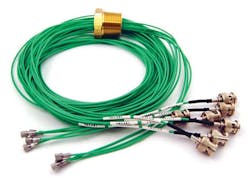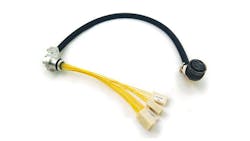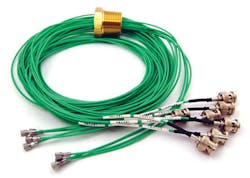This article was updated March 13, 2023. It was originally published April 15, 2014.
When engineers need to get power and signals through the walls, especially those of pressure and vacuum chambers, they usually opt for off-the-shelf sealed bulkhead connectors. These connectors can certainly provide a pathway for wires and cables, but they can also unnecessarily constrain designs, increase costs and cause electrical problems.
READ MORE: Static Bulkhead Connectors - Pneumadyne Inc.
Custom-built sealed wire feedthroughs can be better alternatives. Such feedthroughs pass conductors in a wire harness though walls with no loss of pressure or vacuum, thanks to a hermetic epoxy seal. They also eliminate the voltage drops and contact-resistance issues that can plague connectors. And when used in the right applications, feedthroughs, despite being custom-made, boast a lower installed cost than comparable bulkhead connectors. Often, these advantages give engineers the design flexibility needed to come up with the best design—flexibility not available with bulkhead connectors.
Pros and Cons
Connectors let operators quickly connect and disconnect wires and cables from both sides of a wall. But engineers should specify high-quality connectors to avoid electrical problems and substandard sealing. Feedthrough applications tend to be “sealed for life.” They cannot be connected and disconnected.
Off-the-shelf bulkhead connectors limit the number and gauge of conductors. Many standard connectors can only handle four different wire gauges with only 10-pin configurations per wire gauge. To combine different gauge wires in the same connector requires special-order from the vendor or the vendor simply cannot supply them.
Continuous wire feedthroughs, by contrast, can accommodate thousands of conductors or just a handful, despite being more compact. This density advantage often means one feedthrough can replace several bulkhead connectors. And feedthroughs don’t jut out from bulkheads the way connectors do. As a result, feedthroughs take up less precious space inside pressure chambers and other tight spaces. This can give technicians more room when moving machine parts inside or outside the chamber.
Equally important, continuous wire feedthroughs let engineers mix-and-match conductors, something off-the-shelf connectors do not. For example, magnetic-bearing applications tend to combine twisted, shielded pairs with thermocouple pairs, a combination that would degrade the signals in most bulkhead connectors.
Wire-Feedthrough Benefits
Even the best electrical connectors suffer more losses than the continuous wire harnesses used in feedthroughs. For instance, typical voltage drops for connectors is more than 1 mV per crimp, plus another 1 mV or more across the mated pin and socket. Contact resistance for connectors is typically as high as 100 mΩ, enough to degrade signal integrity from thermocouples and other sensors.
Wire feedthroughs also have the edge when it comes to mechanical performance. Unlike bulkhead connectors, wire feedthroughs are not wearing items with lives measured in a specific number of connect/disconnect cycles. In nonflexing applications, a wire feedthrough’s life equals that of the wire harness itself. There are no other failure modes.
READ MORE: Sealed Bulkhead Connector
Some engineers mistakenly believe epoxy-based feedthroughs suffer from poor sealing and outgassing. This might have been true in the past, but modern epoxies and manufacturing techniques have eliminated these problems. Epoxies now have rugged mechanical properties and resist chemicals and temperature extremes, making them well suited to challenging operating environments.
For example, many off-the-shelf connectors listed as “hermetic” actually have leak rates of 1 × 10–7 sccm (standard cubic centimeter per minute) of He/sec or more. An epoxy hermetic seal for feedthroughs on the market seals to 1 × 10–9 sccm He/sec in vacuums as powerful as 1 × 10–8 Torr and pressures as high as 15,000 psi. To limit outgassing, some companies, such as Douglas Electrical Components, encapsulates wires in grades of epoxy that suffer just 0.26% weight loss and VCM (volatile condensable material ) is less than 0.002%, good enough to meet NASA’s ASTM E-595 low-outgassing specification.
While continuous feedthroughs give engineers design flexibility and space savings for new pressure and vacuum chambers, older systems can benefit too. Engineers must often add new sensors or instrumentation. Such retrofits can be tricky if the standard connector or opening in the wall won’t let any more conductors through. Wire feedthroughs can usually be modified to squeeze in more conductors.
Engineers are not used to custom products costing less than those chosen from a catalog. But it’s important to focus on total cost of ownership. One continuous wire feedthrough with just one wire harness can replace several bulkhead connectors, each with its own wire harness. This is where most feedthrough cost savings come, by designing, making and assembling fewer harnesses.
Going with feedthroughs rather than bulkhead connectors also opens the door to shorter bill-of-materials (BOM) items and simpler procurement. Feedthroughs also avoid the costs associated with over-engineering connectors, a common problem when off-the-shelf models do not precisely match application requirements. All this lets engineers spend more time on engineering rather than designing wire harnesses.
For a magnetic bearing, a hermetically sealed wire feedthrough will cost about 50% less than a glass-to-metal connector, assuming one off-the-shelf bulkhead connector can handle the tasks. If more than one connector is needed the cost advantage of continuous wire feedthroughs is even more pronounced.
Off-the-shelf and custom bulkhead connectors can pass power and signal wires into pressure or vacuum systems and are often used to do so. But they should not be the automatic choice when such tasks arise. Take the time to assess whether a hermetically sealed wire feedthrough is a better option.
Ed Douglas was the president of Douglas Electrical Components when this article was first published.


